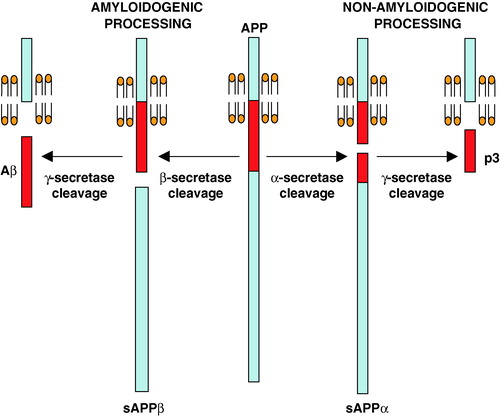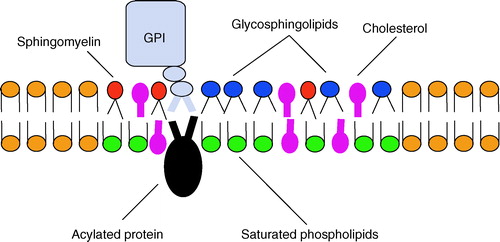Figures & data
Figure 1. Amyloidogenic and non-amyloidogenic processing of APP. The alternative, competitive routes of processing of APP through the consecutive actions of β- and γ-secretases (amyloidogenic pathway) or α- and γ-secretases (non-amyloidogenic pathway) are indicated. This Figure is reproduced in colour in Molecular Membrane Biology online.

Figure 2. Schematic diagram of a lipid raft domain. Lipid rafts represent sphingolipid and cholesterol rich regions of the membrane that selectively accumulate specific proteins, especially lipid-modified proteins. This Figure is reproduced in colour in Molecular Membrane Biology online.

Figure 3. Schematic diagram showing how APP and BACE could interact through raft clustering or through an increase in the number or size of rafts present. Under normal conditions some APP (light blue: online) and BACE (yellow: online) molecules are present in cholesterol-rich lipid rafts (depicted in blue: online) while some are in the phospholipid domains (orange: online). Due to the small size of the rafts, individual APP and BACE molecules are rarely present in the same raft. (A) Following endocytosis, rafts cluster together bringing APP and BACE molecules into contact, as proposed by Ehehalt et al. ([Citation2003]). (B) During aging, or if cholesterol levels are high, the proportion of the membrane forming raft domains may be increased. This would increase the likelihood of APP and BACE being present in the same raft, and allow them to interact to a greater extent. This Figure is reproduced in colour in Molecular Membrane Biology online.
![Figure 3. Schematic diagram showing how APP and BACE could interact through raft clustering or through an increase in the number or size of rafts present. Under normal conditions some APP (light blue: online) and BACE (yellow: online) molecules are present in cholesterol-rich lipid rafts (depicted in blue: online) while some are in the phospholipid domains (orange: online). Due to the small size of the rafts, individual APP and BACE molecules are rarely present in the same raft. (A) Following endocytosis, rafts cluster together bringing APP and BACE molecules into contact, as proposed by Ehehalt et al. ([Citation2003]). (B) During aging, or if cholesterol levels are high, the proportion of the membrane forming raft domains may be increased. This would increase the likelihood of APP and BACE being present in the same raft, and allow them to interact to a greater extent. This Figure is reproduced in colour in Molecular Membrane Biology online.](/cms/asset/5a725a45-049d-4322-9add-4a48c7a2d77c/imbc_a_149624_f0003_b.jpg)